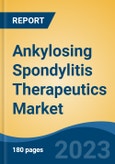Speak directly to the analyst to clarify any post sales queries you may have.
10% Free customizationThis report comes with 10% free customization, enabling you to add data that meets your specific business needs.
AS is marked by inflammation of the sacroiliac joints, connecting the sacrum at the base of the spine to the pelvis. Over time, this inflammation can result in the fusion of spinal vertebrae, severely limiting spinal flexibility and altering posture. Typically manifesting in early adulthood, common symptoms include lower back pain and morning stiffness. Timely diagnosis and effective disease management are essential to enhancing patients’ quality of life.
Ankylosing spondylitis is a global health concern, affecting millions of individuals worldwide. Prevalence rates vary by region and population, with genetic factors - particularly the HLA-B27 gene - playing a major role in disease development. The AS therapeutics market has expanded considerably in recent years due to earlier diagnoses, increased treatment accessibility, and the availability of advanced therapeutics.
Key Market Drivers
Rising Prevalence of Ankylosing Spondylitis
The increasing global incidence of ankylosing spondylitis is a primary driver of market growth. Although AS affects a relatively small proportion of the population - ranging from 0.1% to 1.4% - its impact is significant, particularly among males and individuals in their most productive working years, often beginning in their mid-20s.This growing patient base is intensifying the demand for effective, long-term therapeutic solutions, creating ample opportunities for pharmaceutical manufacturers and healthcare providers. Traditionally underdiagnosed due to its insidious onset and nonspecific symptoms, AS is now being identified earlier thanks to heightened awareness and advancements in diagnostic imaging technologies.
The ability to diagnose AS in its early stages enables earlier intervention, which enhances long-term treatment adherence and drives sustained demand for therapeutic products.
Key Market Challenges
Limited Awareness and Delayed Diagnosis
One of the core challenges faced by the AS therapeutics market is the limited awareness among both healthcare professionals and the general public. Misdiagnosis or late diagnosis remains a common issue, often resulting in delayed treatment and worsened patient outcomes. Addressing this gap through education and awareness campaigns is vital to improving early detection and disease management.Key Market Trends
Technological Advancements in Diagnosis and Treatment
Emerging technologies have significantly improved the diagnostic accuracy and management of ankylosing spondylitis. Imaging techniques such as magnetic resonance imaging (MRI) and computed tomography (CT) are now routinely employed to detect early signs of inflammation and structural damage in the spine and sacroiliac joints. These high-resolution tools facilitate early diagnosis, which is crucial for initiating timely treatment.Additionally, the integration of artificial intelligence (AI) and machine learning in image analysis has enhanced diagnostic precision. AI-driven tools are capable of identifying subtle pathological changes that might be overlooked by human evaluators, further supporting early and accurate diagnosis.
On the treatment front, advancements in biotechnology have led to the development of biological therapies - targeted drugs that address the specific immune mechanisms driving AS-related inflammation. TNF inhibitors have significantly improved patient outcomes by alleviating pain, stiffness, and inflammation. Furthermore, the emergence of biosimilars - cost-effective alternatives to biologic drugs - has broadened patient access to these life-changing treatments, especially in cost-sensitive markets.
Key Market Players
- AbbVie, Inc.
- Amgen, Inc.
- Pfizer, Inc.
- Novartis AG
- Eli Lilly and Company
- UCB, Inc.
- Johnson & Johnson Services, Inc.
- Merck & Co., Inc
Report Scope:
In this report, the Global Ankylosing Spondylitis Therapeutics Market has been segmented into the following categories, in addition to the industry trends which have also been detailed below:Ankylosing Spondylitis Therapeutics Market, By Drug:
- Cosentyx
- Humira
- Simponi
- Remicade
- Enbrel
- Cimzia
Ankylosing Spondylitis Therapeutics Market, By End Use:
- Hospitals
- Clinics
- Others
Ankylosing Spondylitis Therapeutics Market, By Region:
- North America
- United States
- Canada
- Mexico
- Europe
- France
- United Kingdom
- Italy
- Germany
- Spain
- Asia-Pacific
- China
- India
- Japan
- Australia
- South Korea
- South America
- Brazil
- Argentina
- Colombia
- Middle East & Africa
- South Africa
- Saudi Arabia
- UAE
Competitive Landscape
Company Profiles: Detailed analysis of the major companies present in the Global Ankylosing Spondylitis Therapeutics Market.Available Customizations:
With the given market data, the publisher offers customizations according to a company's specific needs. The following customization options are available for the report.Company Information
- Detailed analysis and profiling of additional market players (up to five).
This product will be delivered within 1-3 business days.
Table of Contents
Companies Mentioned
- AbbVie, Inc.
- Amgen, Inc.
- Pfizer, Inc.
- Novartis AG
- Eli Lilly and Company
- UCB, Inc.
- Johnson & Johnson Services, Inc.
- Merck & Co., Inc
Table Information
| Report Attribute | Details |
|---|---|
| No. of Pages | 182 |
| Published | April 2025 |
| Forecast Period | 2024 - 2030 |
| Estimated Market Value ( USD | $ 5.1 Billion |
| Forecasted Market Value ( USD | $ 7.87 Billion |
| Compound Annual Growth Rate | 7.4% |
| Regions Covered | Global |
| No. of Companies Mentioned | 8 |









